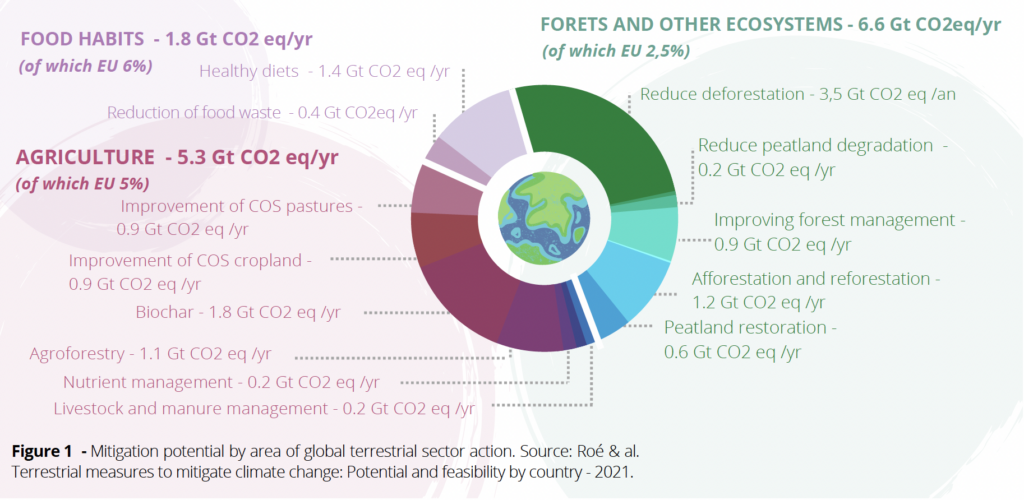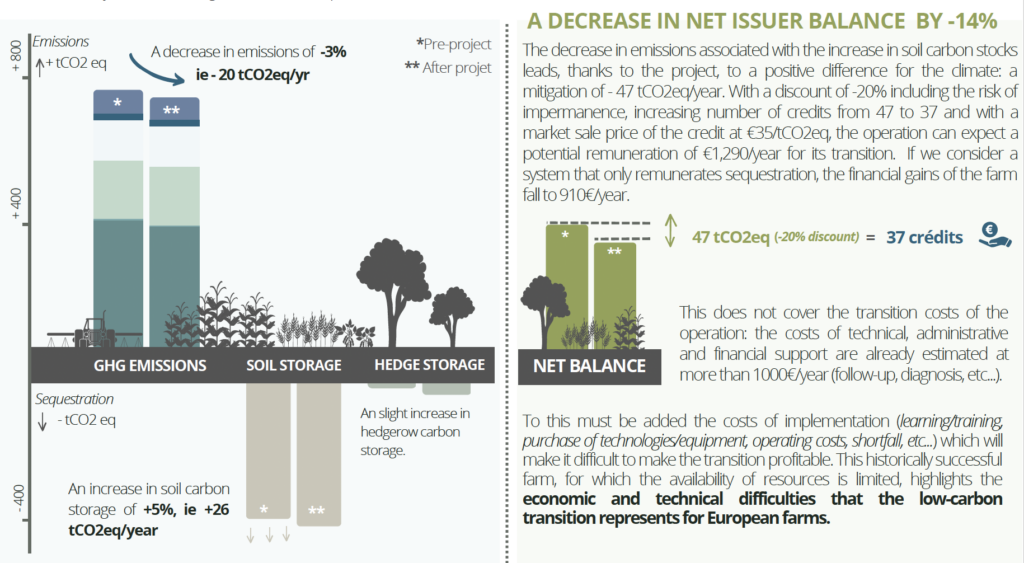The EU agri-food promotion policy is a very important tool to expand sales and increase penetration in international markets. In the current times, marked by the negative effects of the Covid-19 crisis in some key sectors and uncertainty on the future outlook, farmers are even more eagerly reliant upon the boost that promotion programmes bring […]
Our Works
Carbon removal certification: covering both emission reduction & sequestration
To meet its climate objectives, the European Union needs a strategy to support the implementation and deployment of carbon mitigation solutions. The stakes are high: Europe aims to have its Forestry andAgricultural Land Use sector climate-neutral by 2035.
The EU developed a system of incentives that would allow land managers, including farmers, to be rewarded financially for their transition towards low-carbon agriculture. Today, however, the agricultural sector emits 424 Mt CO2 eq/year, while the land use sector compensates for only half of its emissions (net LULUCF balance: -226 Mt CO2 eq).
Therefore, achieving a neutral balance in the next ten years is a major challenge.
Currently, the European Parliament is working on the carbon removal certification framework proposed byt the European Commission, which is a flagship regulation toward this goal. It aims at creating a system of incentives that would reward land managers, especially farmers, for mitigating emissions through the adoption of carbon farming practices.
Carbon farming” includes agricultural practices that allow :
- Carbon removal/sequestration (carbon capture and storage in soil and biomass);
- To avoid future emissions of CO2 and other GHGs (prevention of loss of already stored carbon);
- To reduce existing CO2 and other GHG emissions.
The total global terrestrial mitigation potential is of 13.8 Gt CO2eq/year. Forests and other ecosystems account for the largest share of these mitigation measures, with a potential of 6.6 Gt CO2eq/year or nearly 50% of the global terrestrial potential. The reduction of global deforestation is the action with the highest potential mitigation, amounting to 25% of the total global mitigation potential (3.5 Gt CO2eq/year). Meanwhile, agriculture has the second largest share of land-based mitigation with a potential of 5.3 Gt CO2eq/year, or 38% of the global terrestrial potential (Figure 1).
The EU provides a land-based mitigation potential of 0.52 Gt CO2eq/year, which is less than 4% of the total global mitigation potential. By comparison, Brazil alone represents three times the European mitigation potential (1.6 Gt CO2eq/year), a potential mainly covered by mitigation linked to the reduction of deforestation in the country. Worldwide, 15 countries account for 62% of the total global mitigation potential. Most of thesecountries have, however, low feasibility potential (due to low levels of development).
The European Commission wants to develop a legal framework for the certification of carbon mitigationpractices in the agricultural sector and encourage farmers to increase their contribution to the achievement of climate goals by remunerating them for implementing agricultural carbon mitigation activities. This framework for carbon farming is subject to many uncertainties and issues that need to be addressed to harness its potential against climate change. A robust climate and environmental model is needed. The legislative framework for the certification and remuneration of CO2 elimination/reduction actions will have to address the following issues to ensure results that are compliant with EU climate requirements:
ADDITIONALITY
Only mitigation by carbon agriculture that goes beyond the legislative status quo will have a robust impact on the climate. Additionality is an essential condition in the design of the future European carbon agriculture rewards mechanism.
NO DOUBLE COUNTING
Carbon mitigation is additional if each carbon unit generated is counted only once. Carbon exploitation mechanisms will need to be strict and transparent enough to ensure the integrity of the carbon agriculture reward model.
REDUCTION & STORAGE
Assessing only carbon sequestration resulting from Carbon Farming actions can lead to serious calculation errors. An assessment based solely on sequestration overshadows the potential negative externalities of emission reduction practices. There is a close link between emissions and storage: the same practice can make it possible to increase carbon sequestration while increasing emissions (and vice versa), which can lead to counterproductive results. A results-based model that is robust at the climate and environmental levels must not separate reduction from sequestration.
IMPERMANENCE
Some changes, whether intentional or not, can lead to risks of inversions and losses of captured carbon. It is impossible to guarantee carbon storage in the agricultural sector for as long as it is often required (100 years). In order not to discourage sequestration actions, which in the short term can account for significant amounts of carbon, shortterm storage should be encouraged to stimulate farmers’ transition and investments in sequestration practices. Various mechanisms exist to integrate short-term storage into the carbon market and the associated risk which should be deployed: reserve funds, insurance, rebate systems, etc.
LEAKAGE EFFECTS
Climate change has no borders. If carbon mitigation measures in Europe lead to an increase in emissions in the rest of the world, the real impact of Europe’s climate actions will not be perceived. In particular, carbon farming actions leading to a decrease in European food production could lead to increased compensatory agricultural production at the global level, and therefore towards a less regulated production, polluting and emitting more GHGs. Therefore, the concept of Carbon Farming must be considered in perfect harmony with the primary vocation of agriculture: food production.
IMPACTS AND CO-BENEFITS
There is a risk that some mitigation measures will negatively affect other ecosystem aspects, such as biodiversity, soil health, air and water, or society. The Carbon Farming model will have to be consistent with the various EU environmental directives and regulations. Carbon agriculture programs must be able to support the full social, environmental and socio-economic objectives of the European Green Deal. There are many environmental crises, the climate crisis is just one of them.
Scaling up a Carbon Farming model requires reducing the uncertainties for farmers, and for all stakeholders involved. A standardization effort at the EU level is to be carried out, and the control and certification of these practices will have to follow high standards so that the certificates issued guarantee true environmental integrity.
There are close links between these different Greenhouse Gases (GHGs). Therefore, focusing only on measures of carbon storage or reduction of emissions (CO2, N2O, CH4) can have antagonistic effects and lead to harmful net emission balances.
In particular, because carbon storage in agricultural soils is directly proportional to the amount of biomass produced, reducing the production of biomass leads to risks of carbon removal from the soil.
For example, reducing a nitrogen input (to reduce N2O emissions), mechanically reduces biomass productionand therefore storage capacity. The introduction of pulses can also lead to a risk of soil destocking due to theiroften lower C/N ratio than other crops and sometimes lower biomass production. Conversely, increasingbiomass production by adding fertilizers can increase carbon sequestration in soils but also increase GHGemissions.
It is often difficult to reduce emissions without removing carbon from the soil, and conversely to store carbon in the soil without increasing emissions. These agronomic arguments based on the experience of actors in the field suggest that a method opting for a distinct approach between these two positions would lead to climatic aberrations. A comprehensive measure of the variation in greenhouse gas emissions and carbon storage caused by a project is required.
Links between sequestration and emissions are clear, and the rational at macro and micro level to cover both in the same regulation. Therefore, Farm Europe considers this regulation as a unique opportunity to send a clear signal to EU farmers and to unleash the potential of carbon farming practices, covering both, storage and emissions reduction.
Our case study on a farm in Eastern France confirm the need to cover both reduction and storage in a single scheme for agronomic, climate and economic reasons.
On this farm, since the end of 1990, an increase in the organic matter (OM) content of +12‰ has been identified, directly reflecting a proportional increase in the carbon content of the farm’s soils. This increase in soil carbon stocks should be compared with an increase in irrigated maize areas combined with an increase in crop productivity on the same period.
Maize and wheat crop yields have increased by +100% and +70% respectively since the 1970s. These results showcase the direct link that exists between the amount of biomass produced and the levels of carbon storage in soils.
This data clearly shows that it is possible to increase soil carbon storage while improving crop productivity. Europe’s low-carbon agriculture policy will have to prevent productivity losses in the EU, as the challenges of increasing global export emissions are considerable.
The farm in question has recently embarked on a low-carbon transition through three levers:
- a reduction in GHG emissions from fertilization,
- a reduction in off-farm emissions, and
- an increase in soil carbon storage.
The operating balance after the implementation of the project is estimated at 288 tCO2eq/year (excluding hedge storage), a decrease of -13% compared to the initial situation. This balance represents a relatively high level of emissions depending on whether this figure is related to the ha or tonne produced. The emission level per ha is relatively high (4 tCO2eq/ha/year), while on the contrary, per tonne, the emission level is very low (0.4 tCO2eq/TMS/year). In a context, where leakage effects and food security constitute important climate and security issues, emission levels reported per tonne produced appear to be a more relevant way of measuring the climate impact of a farm.


